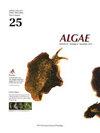泰国-马来半岛上隐藏式柔嫩Bostrychia tenella物种(Rhodomelaceae, Rhodophyta)的系统地理格局
IF 2.4
3区 生物学
Q1 MARINE & FRESHWATER BIOLOGY
引用次数: 1
摘要
在东南亚,海洋大型藻类的遗传多样性和分布模式越来越多。这些研究表明,泰马来半岛两侧的种群之间可能存在显著的遗传多样性和孤立性。tenellla Bostrychia是该地区常见的丝状红色海藻,该实体由至少两个隐蔽物种代表。尽管这种物种复合体具有高度多样性和广泛性,但其遗传变异和种群结构仍然研究不足,尤其是在泰马来半岛周围。我们分析了安达曼海和泰国湾样本的遗传多样性,并使用质体RuBisCo间隔子推断了被鉴定为柔嫩B.tenella的样本的系统地理模式。我们的基因分析证实了两个隐蔽的柔嫩B.tenella物种(B和C)在两个海岸都存在。隐物种B在该地区更为常见,表现出比物种C更高的遗传多样性。历史人口学分析表明,物种B的种群稳定,但最近物种C的种群扩张。我们的分析还表明,安达曼海的两个隐物种都比泰国湾的隐物种具有更高的基因多样性。我们还检测到两个海岸之间的隐蔽物种B的中等到高水平的基因流动和较弱的系统地理结构。相比之下,系统地理学分析显示安达曼海两个神秘物种种群之间的遗传差异。总的来说,这些结果表明,泰马来半岛周围的隐蔽的B.tenella物种可能经历了不同的人口学历史,它们的遗传多样性和系统地理学模式可能是由该地区的地质历史和区域海流环流引起的。本文章由计算机程序翻译,如有差异,请以英文原文为准。
Phylogeographic patterns in cryptic Bostrychia tenella species (Rhodomelaceae, Rhodophyta) across the Thai-Malay Peninsula
Genetic diversity and distribution patterns of marine macroalgae are increasingly being documented in Southeast Asia. These studies show that there can be significant levels of genetic diversity and isolation between populations on either side of the Thai-Malay Peninsula. Bostrychia tenellla is a common filamentous red seaweed in the region and the entity is represented by at least two cryptic species. Despite being highly diverse and widespread, genetic variation and population structure of this species complex remains understudied, especially around the Thai-Malay Peninsula. We analyzed genetic diversity and inferred the phylogeographic pattern of specimens identified as B. tenella using the plastid RuBisCo spacer from samples from the Andaman Sea and the Gulf of Thailand. Our genetic analysis confirmed the occurrence of the two cryptic B. tenella species (B and C) along both coasts. Cryptic species B was more common in the area and displayed higher genetic diversity than species C. Historical demographic analyses indicated a stable population for species B, but more recent population expansion for species C. Our analyses also revealed that both cryptic species from the Andaman Sea possessed higher genetic diversity than those of the Gulf of Thailand. We also detected moderate to high levels of gene flow and weak phylogeographic structure of cryptic species B between the two coasts. In contrast, phylogeographic analysis showed genetic differences between populations of both cryptic species within the Andaman Sea. Overall, these results suggest that cryptic B. tenella species around Thai-Malay Peninsula may have undergone different demography histories, and their patterns of genetic diversity and phylogeography were likely caused by geological history and regional sea surface current circulation in the area.
求助全文
通过发布文献求助,成功后即可免费获取论文全文。
去求助
来源期刊

Algae
PLANT SCIENCES-
CiteScore
5.10
自引率
25.00%
发文量
18
期刊介绍:
ALGAE is published by the Korean Society of Phycology and provides prompt publication of original works on phycology. ALGAE publishes articles on all aspects of phylogenetics and taxonomy, ecology and population biology, physiology and biochemistry, cell and molecular biology, and biotechnology and applied phycology. Checklists or equivalent manu-scripts may be considered for publication only if they contribute original information on taxonomy (e.g., new combinations), ecology or biogeography of more than just local relevance. Contributions may take the form of Original Research Articles, Research Notes, Review Articles and Book Reviews.
 求助内容:
求助内容: 应助结果提醒方式:
应助结果提醒方式:


